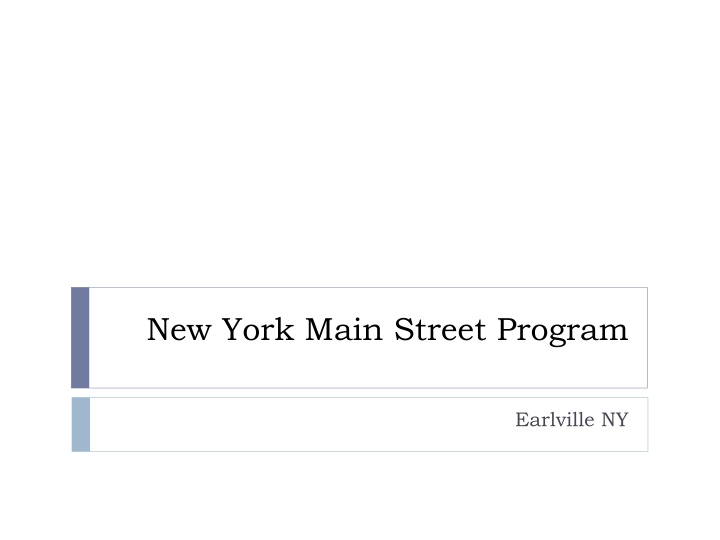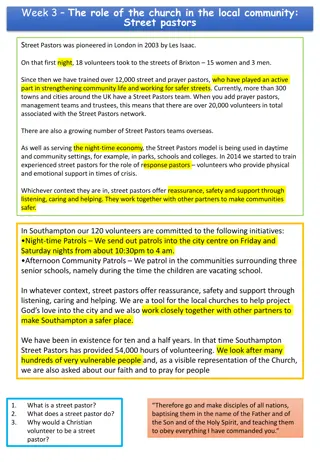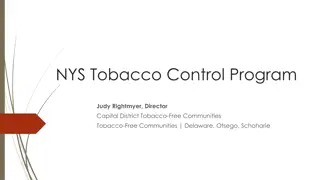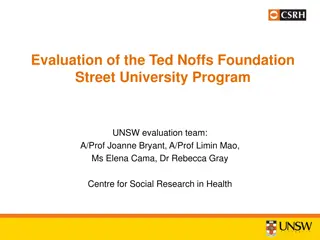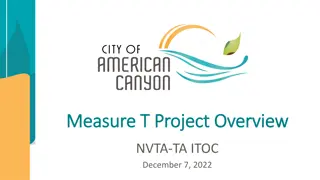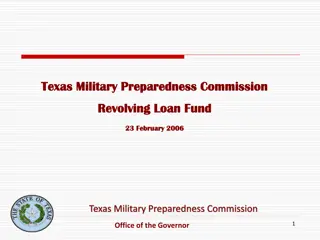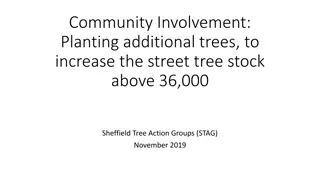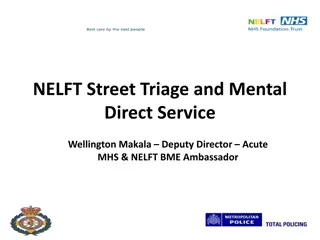New York Main Street Program - Revitalizing Communities in Earlville, NY
The New York Main Street Program, administered by Madison County, aims to revitalize historic downtowns and commercial districts. Eligible projects include renovation of mixed-use buildings, facades, and commercial interiors. Grants cover up to 75% of project costs, with additional funding available for rehabilitating residential units. Projects funded under NYMS must address environmental impacts and historical properties. Contact Stefan Lutter or Laura Caughlan for more information.
Download Presentation

Please find below an Image/Link to download the presentation.
The content on the website is provided AS IS for your information and personal use only. It may not be sold, licensed, or shared on other websites without obtaining consent from the author.If you encounter any issues during the download, it is possible that the publisher has removed the file from their server.
You are allowed to download the files provided on this website for personal or commercial use, subject to the condition that they are used lawfully. All files are the property of their respective owners.
The content on the website is provided AS IS for your information and personal use only. It may not be sold, licensed, or shared on other websites without obtaining consent from the author.
E N D
Presentation Transcript
New York Main Street Program Earlville NY
Contact Info Stefan Lutter Stefan.Lutter@madisoncounty.ny.gov 315-366-2830 Laura Caughlan Lcaughlan@hamiltonpcd.org 315-825-3537
NYMS Earlville What is the program How does it work Next steps
What is the New York Main Street Program? NYS Office of Community Renewal Strengthens New York s traditional Main Streets and neighborhoods Provides funds to revitalize historic downtowns, mixed-use neighborhood commercial districts, and village centers Madison County is the Local Program Administrator (LPA) Rome, NY
Eligible Projects Renovation of mixed-use buildings. Facades (masonry, siding, windows, and doors, restoration of architectural features) Commercial interiors (repairs and updating, particularly of historical vacant or abandoned places) Additional funding available for direct assistance to rehabbing residential units
Not eligible Inappropriate materials (vinyl siding, doors, and windows) HVAC Roofs Demolition/new construction
Grant Details 75% - 25% match Max $50,000 per building, not to exceed 75% of total building renovation project cost Additional $25,000 per residential unit up to per building maximum of $100,000, not to exceed 75% of the total project cost In summary, if your project is $10,000, you will be reimbursed upon completion $7,500.
Grant Details Projects including NYMS funds must produce a finished commercial or residential space, ready for occupancy, within the 24 month contract term. NYMS is a reimbursement grant program funds will be disbursed only for completed projects Environmental effects of each activity must be addressed in accordance with SEQRA prior to the commitment or expenditure of NYMS program funds Each proposed project must be submitted SHPO and reviewed for their potential impact/effect on historic properties
Timeline Applications Reviewed August 12th LPA meets with applicant to develop a scope of work and initial estimate of costs Immediate health and safety concerns Correction of existing code violations Environmental hazards as described in the program environmental compliance checklist Consistency with any other local program design guidelines Preservation of historical elements of the building Projects must be complete 24 months after award
Environmental Review Prior to any physical action on scope: -SHPO Review (review historic impact, may impose conditions on scope) -Site contamination -Lead paint (dwelling units or child occupied facilities, residential floor windows) -Asbestos Cost can be part of overall reimbursement, but roughly $2,000 minimum.
Contractor Selection The LPA will establish a list of contractors able to perform work in compliance with applicable standards. LPA will issue an RFQ List will be used to solicit bids or quotes for the proposed activities Recipients are required to demonstrate good faith efforts to use EEO & MWBE & SDVOB Recipient must submit contractor bid solicitation plan Recipient must complete procurement process for all activities to be reimbursed with NYMS funds. Minimum of 2 bids or proposals must be obtained and reviewed for all project costs. A clear written scope of work for the project must be the basis for the bids or proposals Lowest responsible bidder must be selected
Contracting Procedures The LPA will enter into a contract with the property owner to provide the program financial assistance. The contract will outline the roles and responsibilities for both the LPA and the participating property owner. Contract must specify: Agreed upon scope of work Projected amount of financial assistance awarded Estimated project timeline Requirement to sign and file the NYMS Property Maintenance Declaration form Requirement to sign the NYMS Property Release form (photos) Requirement to engage a contractor and begin construction within 30 days of LPA approval Payments will be made only after work is complete on reimbursement basis LPA has the right to inspect work at any time LPA may terminate the award and cancel the contract should the work be inconsistent with the program rules outlined, agreed upon scope of work or project design, stated timeline or if insurance is not maintained by the participating contractor Property owner will cooperate with the LPA requirement to monitor the ongoing maintenance of the property, including the rent limits for assisted residential units for the 5 year regulatory term
Construction Management / Quality Control The LPA retains the right to inspect work in progress at any point The LPA must perform periodic inspections of the renovation activities to monitor adherence with program rules, environmental hazard compliance, and general project progress A final inspection is required before submitting a final payment request.
Ongoing Maintenance Property owners are required to maintain property assisted with NYMS funds for a period of 5 years from the date of project completion and final inspection. This requires that any assisted improvements be maintained in a manner that is consistent with the goals of the NYMS program for the regulatory term Assisted residential units, when they become vacant, must be marketed and affordable to households with incomes at or below 90% or the median family income during the regulatory term. This requirement is met through a rent limit imposed o the assisted residential unit. The LPA will require each property owner receiving NYMS funds to file a property Maintenance Declaration in a form approved by HTFC with the County Clerk. In the declaration the property owner will declare that he/she has received assistance from NYMS and will maintain the property in a manner consistent with the program objectives for min 5 yrs. In the event of non-compliance or resale, the amount of grant funds will be subject to repayment in accordance with a simple annual declining balance, based on the 5 year regulatory term.
Design Guidelines Secretary of the Interior s Standards for Rehabilitation https://www.nps.gov/tps/standards/treatment-guidelines-2017.pdf
Design Guidelines 1. Materials Existing materials should be refurbished and revitalized when possible, and original materials should be uncovered and restored in appropriate circumstances. When replacing is necessary, choose materials that can be maintained rather than replaced, such as brick, wood, or fiber-cement siding. Avoid imitation siding or vinyl siding.
Design Guidelines 2. Windows For first floor windows, the goal should be no less than 60% of the wall area designated as transparent window space. Storefront windows should not be reduced, and as opportunity presents should be reopened to original sizes. Blinds or other window obstructions should be avoided other than when necessary (for instance, dentist operating room). Thin aluminum or vinyl window framing should be avoided. Second and third story windows should be opened and restored to give the building a more positive appearance. The history of the building should be considered when choosing windows. The original wood windows in this late- 19th-century building, which were highly decorative, could likely have been repaired and retained. (c) Instead, they were replaced with new windows that do not match the detailing of the historic windows and, therefore, do not meet the Standards (above). Historic windows (left) on primary elevation inappropriately replaced with tinted glazing (right).
Design Guidelines 3. Lighting Lighting should be mounted on exterior walls, use ornamental fixtures, and be angled towards the building.
Design Guidelines 4. Signage Signs should feature raised painted lettering, be made of either wood or metal, and when possible be flat against building exteriors or hanging perpendicular signs that interact with pedestrians walking through downtown. Avoid light-emitting signs, vinyl or plastic signs, and use of multiple signs for the same business.
Design Guidelines 5. Doors Avoid aluminum doors or residential doors. Full glass doors should be used for commercial entrances, while apartment entrances should be half glass.
Design Guidelines 6. Colors When choosing exterior colors, building owners should stick to historic palette product lines and choose complementary colors.
Example 1 Funding Amount $75,000 Included: full studs up apartment renovation, complete removal of awning, inappropriate materials, conversion to traditional two commercial entrances and one apartment entrance. Required asbestos mitigation.
Project 2 Funding Amount 20,000 Painting of building, pointing, and restoration of decorative fa ade masonry feature
Project Selection Critera Project Requirements Satisfy Requirement (Yes/No) Project has fa ade component (such as replacement of entry doors, replacement of non-historic windows with appropriate windows, painting, repair and repaint wood trim, repair and replace fascia, repair and replace soffits, repair and replace front steps, replace storefronts) Project addresses existing major issues (such as existing broken windows, rotted wood, vandalized elements, inappropriate doors)
Project Selection Critera Priority given to projects that: Are visually prominent in commercial core Include renovation of upper story residential Historic value or historic property at risk Modernizes a commercial space Removes inappropriate materials Current or historically vacant
Contact Info Stefan Lutter Stefan.Lutter@madisoncounty.ny.gov 315-366-2830 Laura Caughlan Lcaughlan@hamiltonpcd.org 315-825-3537
